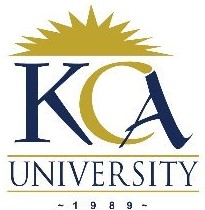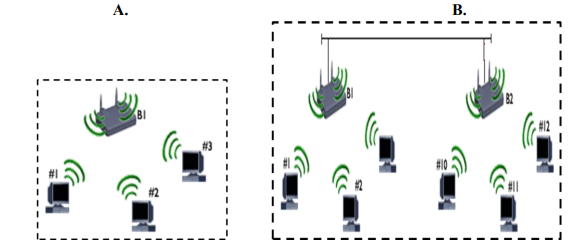
UNIVERSITY EXAMINATIONS: 2017/2018
EXAMINATION FOR THE DEGREE OF BACHELOR OF SCIENCE IN
INFORMATION TECHNOLOGY
BIT3107 WIRELESS NETWORKS
FULL TIME/PART TIME/DISTANCE LEARNING
DATE: DECEMBER, 2018 TIME: 2 HOURS
INSTRUCTIONS: Answer Question One & ANY OTHER TWO questions.
QUESTION ONE (30 MARKS)
a) Define the following terms (5 Marks)
i) Wireless network
ii) network monitoring
iii) Communications Satellite
iv) MAC
v) Mobile Ad hoc Network (MANET)
d) Highlight the four dimensions that wireless channels can be multiplexed (4 Marks)
b) Describe the following network fundamental categories (4 Marks)
i) Infrastructure-based
ii) Infrastructure-less
c) Contrast between wired and wireless networks (7 Marks)
e) The following diagrams showing two WIFI IEEE 802.11 LANs, study them and answer
questions that follows
A. B.

i) Giving reasons, categorize each of the networks A and B as an infrastructure or an ad hoc or
network
(4 Marks)
ii) If ccomputer 1 in network A transmits to Computer 2 in the same network, how many separate
times will the data need to be transmitted? Explain (3 Marks)
iii) If ccomputer 1 in network B transmits to ccomputer 12 in the same network,, how many
separate times will the data need to be transmitted? Explain (3 Marks)
QUESTION TWO (20 MARKS)
a) Highlight FOUR techniques used for MAC management (4 Marks)
b) Justify the truth or falsity of the following phrase and give relevant practical situations
‘wireless does not always mean mobility’ (6 Marks)
b) Describe the functionality of the Random Waypoint (RWP) Synthetic Uncontrolled
Mobility Model (10 Marks)
QUESTION THREE (20 MARKS)
a) Describe the functionality of the Reference Point Group Mobility (RPGM) Synthetic
Uncontrolled Mobility Model (8 Marks)
b) The following diagram shows five computers using WIFI IEEE 802.11 and each
computer’s transmission range is depicted by a circular region. Study the diagram and answer
the questions that follow

i) If computer A transmits a message, which computers will hear that communication? (1 Mark)
ii) If computer D transmits a message which computers will hear that communication? (1 Mark)
iii) Describe the implication of the situation where computer D hears a RTS but not the
corresponding CTS (3 Marks)
iv) Describe the implication of the situation where computer A hears a CTS but not the
corresponding RTS, (3 Marks)
v) Explain whether it is possible for computer B to be transmitting to computer A at the same
time that computer C is transmitting to computer D (4 Marks)
QUESTION FOUR (20 MARKS)
a) Explain FOUR key factors contributing to higher security risk of wireless networks
compared to wired networks (8 Marks)
b) KCA University is contemplating launching of a communication space satellite as a means
of facilitating wireless communication among its various campuses within the East Africa
region. As a member of the advisory panel describe the advantages and disadvantages of
Satellite Communication (12 Marks)
QUESTION FIVE (20 MARKS)
a) Give reasons why RTS/CTS mechanism is by default disabled in IEEE 802.11standard
(4 Marks)
b) Explain each of the following Association-related Services with respect to network
mobility (8 Marks)
i) no transition
ii) BSS transition
iii) ESS transition
c) Elaborate the differences between cellular and Ad-Hoc Networks (8 Marks)